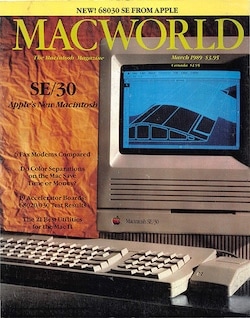SE/30 Forever
< Back to homeLast Updated: 18/12/2020
History
The Macintosh SE/30 was Apple's attempt at offering a compact version of a more capable, expandable Mac. They released the SE in 1987, and while it was expandable, it was limited in its performance without expensive processor or memory upgrades. Until the SE/30 was released, the Macintosh II line of computers, or shelling out for expensive memory upgrades and accelerator cards for your compact Mac, was the only way to get a more powerful Mac.
The SE/30 is based on the Macintosh SE but there are important differences between the machines. The SE/30 combines the modularity of the original SE with the capabilities of the larger and more powerful Macintosh IIx. Although the name implies that the SE/30 borrows many characteristics from the SE, there are several differences between the two models.
The SE/30 was launched at a time when Apple focused primarily on high-end models with equally high prices. There was no Mac available for less than $1,000 before the release of the Macintosh Classic in 1990.
The naming convention is based on the Motorola 68030 processor used in the SE/30. Apple had stuck to a naming convention of adding an 'x' to the model name to denote the inclusion of a 68030, but with the SE this would've resulted in the unfortunate name SEx, so SE/30 was chosen instead. The SE/30 was codenamed Green Jade, Fafnir, and Roadrunner during its development.
As described in Apple's brochure for the SE/30, it was intended for users looking for maximum performance from a compact computer system. It provided four times the performance of the Macintosh SE, in the same formfactor, and could run the same software as the SE. The markets that Apple targeted included higher education, consultants, accountants, business and government. During Apple's preview of the machine, there was also a focus on the higher education market and the concept of the SE/30 as a music workstation. Apple's marketing team put a lot of emphasis on the machine's sound and music capabilities and referred to third party expansion boards containing digital sound processor (DSP) chips.

MacWorld US March 1989 issue. Navigate this issue at archive.org
Features
Configurations
Apple offered three configurations of the SE/30:
Upgrading from an SE
As with other Mac releases, Apple offered an upgrade path for existing SE users. If you already owned an SE, you could pay Apple to upgrade your logic board to an SE/30 board and upgrade your 800K floppy disk drive to a FDHD drive capable of reading 1.4 Megabyte disks.
There was no upgrade path offered for 128K, 512K or Plus owners.
Replacement
The SE/30 was discontinued on October 21, 1991. The SE/30 was superseded by the Macintosh Classic II on the same date the SE/30 was discontinued, a far less expandable model that could only accept a maximum of 10MB memory, compared to the SE/30 which was capable of a maximum of 128MB. The Classic II did not inherit the SE/30 PDS slot, meaning it can not be expanded in the same way as the SE/30. There isn't really direct evidence for this, but after the SE/30 was discontinued, it
Support was officially discontinued by Apple on September 1, 1998.
Legacy
The choices Apple engineering made in opting for a 68030 processor and 68882 coprocessor for the SE/30, in addition to the internal expansion slot and 8 RAM slots, meant the SE/30 was prepared for the long term. Although Apple only offered the SE/30 for sale for a relatively short period, from January 1989 to October 1991, this model of Macintosh was used for many years to come by users.
Even today, users are working on modern hacks to keep the SE/30 relevant. In comparison to many Macs of this vintage, the SE/30 does not feel slow, and with adequate memory expansion available (up to 128MB) you can run any software that was designed for it. Some might say that Apple over engineered the SE/30, to the point where it was useful for too long. It was also one of the most reliable compact Macs (recent neglect of many models is starting to taint this reputation, because of age-related wear such as worn out electrolytic capacitors and leaking PRAM batteries), with fewer analog board failures than earlier models.
The characteristics of the SE/30 make it one of the most popular models for collectors. The SE/30 is also one of the most commonly repaired/refurbished models by collectors. By this point, at time of writing in May 2020, working SE/30s are becoming harder to find, being a less common sight than the cheaper models like the Plus and SE. They are also going up in value, with a fully working, restored SE/30 being worth upwards of $500 and a fully working model with original packaging worth in the region of $1,500-3,500.
Corrections
Please inform us of any corrections required. If you think we made a mistake, we would like to know so that we can correct it.